#the date of the print perfectly matches the time period of the story
Text
A-T-3 115 OMD - Dazzle Ships
Ducktales Pt.2
Continuing my counter-narrative to tory stories about immigration, refugees, and asylum seekers they (con)fuse together under the slogan 'stop the small boats'
As we’ve seen with Small Boats (A-T-3 114), like we did with City Pop (A-T-3 095), and Origins Of Hip Hop (A-T-3 098), dates, events, circumstances, facts and figures used in narratives don’t have to be true they just need to sound convincing (like chatGPT)
The 'small boats' story appeals to what academics call 'directionally motivated reasoning.' This is when we seek out what we want to hear ('confirmation bias') and filter out everything we disagree with ('disconfirmation bias'), finding ideas and attitudes that match our own more convincing than those that don't
Empty container words such as 'woke' have become massively popular with grifters on the right. 'Woke' can stand in for any and all of a persons frustrations and neatly provides an 'other' to point at. There's a very funny interview from the other week with a conservative author who has written a book on the terrors of 'woke' culture not being able to explain what 'woke' is https://youtu.be/N-G50bhldQo. Calling 'woke' an empty container isn't entirely true, it's true when used by right-wing politicians and commentators, but as the presenter of the clip above correctly states 'woke' or 'stay woke' comes from Black activists call for awareness of (being awake to) racial injustice
Another word right-wingers have imported from America is referring to asylum seekers as 'illegal' when they are not. This is received wisdom, if it's repeated enough people will believe perfectly legal asylum seekers are in fact illegal, and we live in a hierarchical class-based socially conservative society (remember the queen's funeral) one where sadly people listen to their 'betters' even when they're completely untrustworthy

The picture above was made in Midjourney. I think the story it's trying to tell is trying to tell is problematic, it could be Home Secretary Suella Braverman coming to the UK on a 'small boat'. I don't think the image achieves 'putting Suella Braverman in the shoes of asylum seekers' worse I think it humanises her when she's really not a humanitarian. Braverman is hated on the left to the point it may support her ridiculous case, given the choice would you want Suella Braverman coming to the UK? Then there's here skin colour, to say she looks like an asylum seeker isn't on. Suella Braverman's interest is preserving the upper-classes
I prefer this one although it's a bit esoteric innit (unlike the image above)
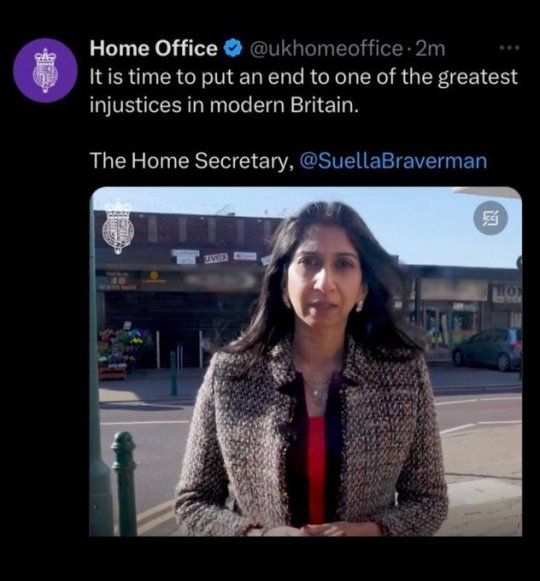
The dazzle ship in this story is the Bibby Stockholm which has been used to house asylum seekers before with disastrous consequences, but this time it will be different, right! Well no, again it's virtue signalling. The Bibby Stockholm can accommodate up to 500 asylum seekers, the governments backlog of applications in 161,000, this proposal will house 0.3% of the people waiting to have their applications processed, we'd need 322 Bibby Stockholm's to accommodate everyone. Then there's the issue that the Bibby Stockholm is effectively a floating prison
OMD - Dazzle Ships the story goes as I understand it Mancunian graphic designer Peter Saville see's geordie vorticist Edward Wadsworth's 1919 painting Dazzle-ships in Drydock at Liverpool in Liverpool's Walker Art Gallery (one of my locals - check out his black and white prints from this period)
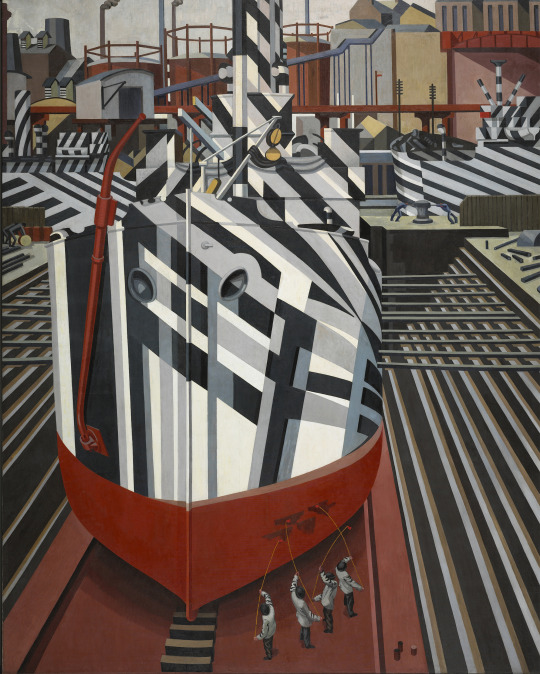
From there the concept for the album was born. Liverpool also has a copy of Audubon's Birds of America which takes pride of place in Liverpool Central Library. Audubon is coming under criticism in America with his name being removed from national bird watching societies because of his racist views and ownership of slaves
OMD - 66 And Fading
youtube
OMD - Of All The Things We've Made
youtube
#1983#orchestral manoeuvres in the dark#omd#synth pop#electronica#experimental#peter saville#liverpool#england#uk#80s music
0 notes
Text

I do not wonder at my poor father's senses being dazzled, for, as he said to me, "You see, Jack, after being used to see nothing but Point women, all so slack in stays and their rigging out of order, to fall aboard of a craft like your mother, so trim and neat, ropes all taut, stays well set up, white hammock cloths spread every day in the week, and when under weigh, with a shawl streaming out like a silk ensign, and such a rakish gaff topsail bonnet, with pink pennants; why, it was for all the world as if I was keeping company with a tight little frigate after rolling down channel with a fleet of colliers: but howsomever, fine feathers don't make fine birds, and handsome is, as handsome does."
— Frederick Marryat, Poor Jack
A Man of War, towing a Frigate into Harbour, 1781 print after Robert Dighton.
#frederick marryat#captain marryat#age of sail#sailors#1780s#robert dighton#poor jack#maritime art#english literature#british literature#the date of the print perfectly matches the time period of the story
19 notes
·
View notes
Text
Predator's Game
Rated 17+
Trigger warning list will be updated as game is created.
Your family was an odd one. Your mother a werewolf and your father a wildlife researcher who dedicated his life to researching and studying predators of all kinds. When he met your mother his world was turned around and he dived head first into the world of monsters. You inherited your mother's lycanthropy and your father's unorthodox nature journals. The natural habitats, their diet, culture, temperament, and how dangerous each creature is to humans all messily scrawled in composition notebooks and leather bound journals. Your mother and father are long divorced but left on good terms.
You are now attending Inquisitorem College. Its a small college in a small town that seems perfectly presentable. If you ignore the forest surrounding it and the lake that is always just a bit too still. The college knows your family well, your mother in particular.
———
Attend college, meet people, make friends, date, and drag them all into nightmare scenarios as you are and the rest of the school are terrorized and hunted by the creatures your mother used to live with and the ones your father studies.
The first two or so years of college are always an adjustment period for students not used to living away from the safety of home.
DEMO: TBA
Features-
-Fully customizable MC (sexuality, gender, amab/afab, appearance, and personality)
-Be a werewolf! Tear flesh and eat plants outside you could never as a human!
-Learn about creatures and study them like your father or study them to go full monster hunter.
-Learn about naturalism and herbalism to make potions on your free time.
-All romantic options are optional and you can choose one or two ROs to be your main platonic partner if romance isn't what you're interested in!
Romance Options-
Theo Walterson - She/they . . . amab nonbinary . . . . . . . . . . . . . . . . . . . . Theo lives in the dorm room across from you. They work part time at the college library and practically live there. Theo is smart and stubbornly optimistic. They were also born with one eye, a condition called anophthalmia. As a result she have a prosthetic eye that matches their hazel eye that she was born with. She wears glasses to help protect their prosthetic. Theo is also a bit of a prankster, often not telling people about her prosthetic before they decide to pop it out or simply adjust it a little to give them a bit of a shock.
Jase Park - They/them . . . afab transmasc . . . . . . . . . . . . . . . . . . . . . . . . Jase is dorm mates with Theo. Most of the time they can be found either in the undergraduate blood disease research lab that the college is most known for or out on the track. With a full ride scholarship in exchange for Jase being part of the school's track team, Jase is busy most of the time but always makes time to help Theo prank unsuspecting victims. They are energetic, competitive, and love to crochet little trinkets and plushies for their friends.
Alicia Wools - She/her . . . afab cis woman . . . . . . . . . . . . . . . . . . . . . . . . . Alicia is dorm mates with you. She works for the school's newspaper. She is usually found with her reusable coffee cup in hand as she reads entries for stories to be added to the weekly printing of the newspaper. She is determined, kind, and strict in her own moral code. She keeps her side of the dorm clean and she often brings you food form the cafeteria when she knows you haven't eaten in a while.
Dayton Letterman - He/they . . . amab cis man . . . . . . . . . . . . . . . . . . . . . Dayton lives off of campus but is friends with Alicia. Dayton keeps to himself with a side job in the student archives. Logs of student research projects long put away are his main company outside of classes. He used to be outgoing and confident before the incident over the summer. Dayton is now quiet and seemingly always aware of his surroundings. They are brave, kind, and they don’t freeze in a panic but you might have trouble finding him afterwards.
21 notes
·
View notes
Text
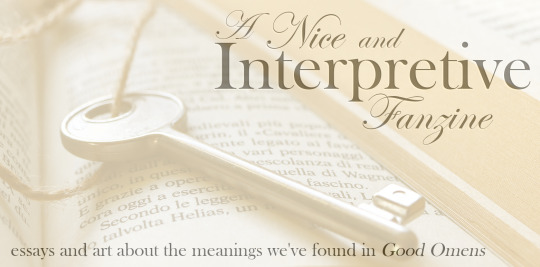
[ID: A cream-colored banner that says "A Nice and Interpretive Fanzine: essays and art about the meanings we've found in Good Omens." There is a photo of a book page with a key on it behind the banner text. The photo source is rosy_photo on Pixabay. /end ID]
A Nice and Interpretive Fanzine: Information Masterpost
Welcome!
This is a zine for those of us who love the subtle, complex work that is Good Omens, and who’ve enjoyed the thoughtfulness of the fandom as people interpret how the many moving pieces of the story come together, creating a slightly different meaning for each of us.
To put it simply, it’s a book full of the fandom’s own analysis and commentary about the Good Omens TV show, enhanced with illustrations from our brilliant artists.
This zine is analytical in the sense that all the writers are expressing their own nonfiction thoughts and feelings about the show, rather than writing fanfic, but it is not meant to be heavily academic. Anybody who likes to pick apart the series and discuss it should be able to enjoy it.
The zine will contain essays by fans who are passionate about analyzing and interpreting different parts of Good Omens - the characters, the plot, the writing techniques for the book and script, the cinematography of the TV show, the popular content of the fandom itself. Accompanying these essays will be black and white illustrations from our artists.
How are you organizing this process?
May 1-May 15: Everyone submits their application to do writing or art through a Google form. Behind the scenes, I’ll be setting up a separate email and Discord.
May 16-20: Applicants will be screened during this time.
May 20: I’ll email everyone to let them know the outcomes of their applications. The final participants will get a link to the Discord server for the zine (totally optional, of course).
May 21: If there’s any clarification or solidifying of ideas that needs to happen, I’ll contact you and discuss with you by this point. This is also when artists will be matched up with essays.
May 22 to August 14: This will be a period of just working on our essays and art. The Discord chat and Tumblr will be there for support and for exchanging ideas!
August 15: Participants need to email their full works to the zine’s email address by this date. No special formatting is needed; I’ll do that in InDesign.
August 15 to August 31: I’ll be putting the zine together in InDesign.
September 1: Preorders will open.
September 30: Preorders will close.
October 1: The zine order will be placed!
October 15: Assuming all goes well with printing and shipping, the zines will be shipped out in waves starting on this date. If the printing or shipping from the manufacturer is delayed, then shipping will just start ASAP.
Writer Application HERE
Artist Application HERE
Asked and Answered Questions on Tumblr
The Fanzine's Page on Twitter
Read below for more detailed information about the zine in a Q and A format!
What are the specifications for the zine contributions?
For writers, I’m starting with 3k words or fewer per essay (approximately 10 pages at the size of this book). This depends heavily on how many participants we actually get, so it may change!
For artists, I’d be looking at black and white works, 300 DPI, 5.5 x 8.5 inches or smaller. If your art is supposed to fill up the entire page (i.e. no white space), please make it a total of 5.75 x 8.75 inches with nothing too important around the edges to account for bleed during the printing process.
Can I submit an essay to this zine if I’ve already posted it on Tumblr?
Not as you’ve already posted it. We don’t want to just copy/paste the exact thing that hundreds or perhaps even thousands of people have already read.
However, it IS fine and maybe even a good idea to take the same thought from your post and refine it, preserving your same thesis. For example, a lot of Tumblr posts are just us fans jotting down 5 or 6 paragraphs of random thoughts at 2 AM, but some of them are really cool thoughts! Expanding them and turning them into a bona-fide Essay would make those posts into excellent zine chapters. And you can copy small pieces of your own language as long as the whole thing isn’t just pasted word-for-word.
How long do essays have to be? Is there a limit?
With the number of writers we have, I've calculated that each person should ideally keep their essay to about 6000 words. There is wiggle room.
There’s no real minimum for your contribution; some analytical ideas are really good but can be expressed concisely, so it’s okay if your essays only come out to a few pages typed. For reference, with our book size, a page is about 300 words.
What happens if the zine sells a lot and you end up not only breaking even, but turning a profit?
It’ll go to charity. While I’ll ask the participants what they want to do for certain if we do make enough money, my suggestion will be donating it to Alzheimer’s Research UK in honor of Sir Terry Pratchett.
I’m not really comfortable calling this a “charity zine” up front since I simply don’t know if it will raise a significant amount. For the most part, I just want the thing to physically exist, which means breaking even, and don’t want to make it more expensive for buyers than it needs to be to afford the printing costs.
What kinds of essays are you talking about? What could be included?
In short, any analytical thoughts about the Good Omens TV show - and possibly even the fandom as it interacts with the show - are possible inclusions for the zine.
To expand a bit, think about the meta posts you see floating around Tumblr. Often these involve analyzing characters, or picking up on patterns in the plot. Sometimes fans use their own background knowledge to write posts about the significance of certain costume choices or the way music plays into each individual scene. Some posts examine the ways the series approaches gender, while others might discuss ways that the characters present as neurodivergent. That’s how diverse the pool of possibilities is for subjects in this zine.
How does art come into this?
Images will be black and white, to match the bookish mood of the project overall. Images can range in size from a half page to a full page.
I’m planning to talk to the artists and authors and loosely pair artists with essays that appeal to their personal interests.
I know how to illustrate a story, but how do I illustrate an essay?
There are infinite answers to this! I’ve seen some beautiful symbolic artwork in the fandom already (e.g. a number of takes on Aziraphale munching on an apple with Crowley in snake form curving around him), and there are tons of symbolic motifs to draw from, but these are not the only options. An artist illustrating an essay about cinematography, for example, could draw a well-known scene from an alternative angle. An essay about Heaven as a capitalist corporation could be illustrated with a cartoon of Gabriel giving some sort of excruciating PowerPoint presentation. A character analysis could be accompanied by a simple portrait. And on and on. I’m not interested in limiting the possibilities by trying to make a list, but just know that there are many and you don’t have to make it complicated if you don’t want to.
If the writers can reuse their essay ideas, can artists reuse their drawings?
Similarly to the writers, if you already have an interpretive drawing that you’re in love with, artists can use the same ideas and the same fundamental composition that is present in their own existing work. However, it has to be redone in some significant way. Whether it’s taking something you drew in 2019 and redrawing it using an updated style, taking a sketch and turning it into a lined and shaded piece, or redoing a full-color drawing so it presents more strikingly in black and white, it shouldn’t be identical to the thing you’ve already posted.
So how are you choosing participants here?
It’ll be based on what people are interested in writing about (or illustrating). I’ll be looking for people who are passionate about their essays, but I’ll also be looking for variety. It all depends on what people want to offer, so I won’t know for sure what it will look like put together until everyone’s application is in.
For artists, I’ll be trying to figure out whose style looks like it would adapt well to illustrations in black and white, and also who demonstrates an interest in the same subjects as the writers.
If we don’t get a lot of applicants, I’d love to simply include everyone, but I can’t commit to that without knowing for sure how many people are involved.
Do I have to use a formal writing style to participate?
No. You should use a style that makes your thoughts and ideas as clear as possible, but as long as it’s understandable, you can also get a little artistic with it. You can “write like you speak,” though perhaps in a more organized way. You definitely don’t need to worry about stylistic rules like not using the first person. This is not academia.
Is this zine going to center only on Crowley and Aziraphale?
That remains to be seen! It depends on what ideas show up in the applications. There will be a lot of the ineffable partners for sure, but whether the whole zine will center on them or whether there’s plentiful stuff about other characters will depend on what the participants suggest.
Do we have to agree with all your personal interpretations of Good Omens to be in the zine?
No! In fact, I’m assuming that a number of essays will contradict each other, too, and that’s perfectly okay. The zine is a sampler of fan interpretations meant to inspire, not instruct. It’s not “Here’s a fan-made guide on how to understand this TV show,” it’s “Look at all these moving parts and how many meanings we can find in them. What does it mean to you?”
However, there are some basic rules and assumptions by which I’m working here.
I don’t personally have the energy to include essays that are highly critical (“negative”) in this zine. It’s analytical but also meant to be fun.
I’m pretty focused on the TV adaptation. This isn’t “no book analysis allowed” but just that the essays will end up being weighted toward subjects that apply to either the TV show or both the book and the show.
Each writer should focus on making their own points over disproving other fan interpretations. If you’re writing in an expository style, it’s normal for the essay to contain rebuttals to opposing ideas, but these should be minor supporting points, not the heart and soul of your essay. For reference, I’d say the majority of meta I see floating around on tumblr would follow this rule just fine.
Essay ideas that seem to contain bigoted or exclusionary sentiments will not be accepted (no TERFy stuff, for example).
What kinds of editing will go into the zine? Are you going to argue with us about the contents of our writing?
While I might ask you to elaborate on certain points in your writing or clarify your thoughts about your subject, I’m absolutely not here to ask you to change the thesis, opinions, or headcanons on which your writing is based. If I really have a problem with your initial idea, I’ll tell you that up front and politely decline the contribution.
While formatting the zine, I’ll make minor edits if I think I see a typo or misspelling, something small and obviously unintentional. As with any other zine, your content won’t be changed without consulting you.
Is this a SFW zine?
Yes. If people want to discuss sexuality in a theoretical way, like erotic subtext, that would be allowed. There are canon references like Newt and Anathema’s moment under the bed that might come up, too. But there will be nothing explicit, and since these are essays instead of stories, there will be no “action” going on between characters. Let’s just say sex isn’t a forbidden topic, but it will be like discussing it in English class.
As for other topics that could make the zine NSFW, like gore or extreme language, I don’t think they will be an issue. Some dark topics, like abuse by Heaven and Hell, may be discussed, but they will be warned for, and these are not stories, so you aren’t going to see violent actions playing out.
Will there be any “extras” like charms or stickers?
I’m not sure yet. I’m most inclined to keep it simple, because of the nature of the zine, but would be open to including some bonus items if there’s an artist who’s really passionate about it.
With that said, I am pretty committed to making a hardcover edition of the book available, in addition to the standard softcover version.
You’re doing this with only one mod?!
Yes. I personally find it easiest. While I’ve worked on multi-mod projects in other domains and adore all of my co-mods, it’s a little bit different when it’s a project with this many moving pieces that includes real-life components like printing and shipping. Though there are a lot of individual things to be done, I am experienced with all of them, so it’s less overwhelming to just take on the whole project. That way, I know exactly what needs to be done and when, and there are no issues with assigning tasks.
What qualifies you to run this zine?
The résumé answer: in fandom, I successfully solo-modded a large not-for-profit zine in the past, the @soulmakazine2018, and while I can’t speak for the whole fandom, it definitely seemed to be well-received. <3 In real life, I’m a case manager and this involves coordinating and communicating with a lot of different people including my 100-person caseload, budgeting services, and filling out all kinds of paperwork on the fly, all skills that can be imported into zine work.
The practical answer: well, I’m the one who decided to start this project, so if you like the sound of it, you're stuck with me. I say with encouragement and enthusiasm that if you’d like to do a different take on a commentary zine, you should absolutely do it.
89 notes
·
View notes
Note
Corbyn and Lori's story: How they met, how he asked her out, their first date, everything LOL ~ T
I just wrote a quick one for this one but this is the story of how Corbyn and Loretta started dating. Dating him right brought her out of her shell but at this point she was quite shy.
October 1957
Corbyn and Loretta met in high school and they started dating pretty quickly actually. Corbyn was a year older so he was in grade 12 when she was in grade 11 and thus they had no classes together or anything, but Loretta always spent her study hall period in the library and Corbyn happened to have his study hall at the same time. Most often, he would go out with friends for study hall but one day he actually had homework to complete so he headed to the library to get some done. It was busy that morning and all the tables were taken up except the last one in the row; only occupied by one girl with her nose in a magazine.
Corbyn dropped his textbook on the table across from her a bit harder than intended and she startled.
“Sorry.” Corbyn said quickly, “Can I sit here?”
Loretta only nodded before turning back to her magazine. Corbyn slid out the chair and sat down, his leather jacket squeaking a little as he moved and opened up his textbook and notebook. He glanced up at the girl across from him and stared at her a moment, how her brown hair was curled nearly perfectly over her shoulders and tied with a red ribbon and how her painted lips were set in a calm smile as she read, curling the corner of the page haphazardly.
Corbyn cleared his throat and she looked up at him again.
“Do you…have a pen I could borrow?” he asked sheepishly.
Loretta cracked a small smile and nodded before bending over to reach into her backpack on the carpet beside her. She unzipped her pencil case and passed him over a red pen.
Corbyn’s lips perked into a crooked smile as he took it from her, “Is red your favourite colour?”
Loretta’s eyebrows furrowed at his random question but then noticed her pen, her matching pencil case, and her red dress and hair ribbon. “Oh.” she flushed slightly. “Yes. It is.”
“It looks good on you.”
His smooth line had her blushing harder and she turned back to her magazine with a mumbled thanks. No one could deny Corbyn’s attractiveness and the way he was so obviously flirting with her had her shyer than ever. They sat together for the rest of study hall, quiet and working, both sneaking glances up at the other when they weren’t looking. Loretta’s bottom lip was nearly raw from biting it so nervously for the entire period and when the bell rang she shot right up to rush out of the library, head ducked to prevent the senior to see her embarrassment.
The very next day, Corbyn returned to the library during study hall and approached the same table, clearing his throat again and holding out the red pen into Loretta’s line of vision. She glanced up at him and smiled shyly as she took her forgotten pen back.
“You left in such a rush yesterday.” Corbyn explained as he helped himself to the chair across from her again. “What are you reading?”
“Nothing of importance. Social garbage.” Loretta shrugged, her voice soft, and she closed her magazine to reveal the gossip titles. The picture of Elvis on the cover was the only reason she bought it in all honesty.
When he didn’t say anything, Loretta looked up at him again. Their eyes met and she looked away again quickly, feeling her cheeks flushing pink. Corbyn smirked to himself and leaned his forearms against the table, folding his hands together and Loretta’s downcast gaze caught on his few rings he wore.
“Can I take you to dinner on Friday night?” Corbyn asked.
Loretta gasped lightly and looked up at his face, “I-I-I’ve never…like on a date?”
“Yeah? Sound okay, doll?”
Loretta flushed a furious pink at the nickname and Corbyn only smiled wider at the effect he was so clearly having on her. She looked him in the eye as if expecting it to be a joke but he peaked an eyebrow in impatience for her answer.
“I suppose so, yes, I would like that.” Loretta finally answered.
“Swell.” Corbyn tapped the table with his hand as he stood up again. He reached over to grab the pen from her hand and scribbled his phone number on the corner of the cover. “Call me tonight.”
“Okay.” Loretta whispered through her shy smile.
He sent her a wink as he picked up his bag and headed out of the library.
Loretta let out a heavy breath once he had turned the corner and was out of sight and she looked down to the seven digits printed in his handwriting on her magazine. She had never been asked out before – and especially not by a senior – and the whole idea had her giddy with excitement.
So she called him that night and they made a plan for Friday so after school, Corbyn met her at his car and they drove downtown to the restaurant. He opened the doors for her and everything and Loretta felt like she had butterflies in her heart the whole time. She was nervous but she played it off well, always being raised with proper manners that she had instilled in her like second nature. Corbyn ordered for them but she was too giddy to even mind; she figured he knew the menu at this place better than she did anyway.
They shared good conversation over dinner and got to know each other better and Corbyn could make her laugh until she needed a glass of water to calm down. Since both of them weren’t eighteen yet, they didn’t have to worry about if they were each other’s soulmates but Loretta secretly hoped they were. He was gorgeous and smooth and funny and cool and seventeen-year-old Louisa was sure she was smitten. Was there anyone more perfect? Probably not.
Corbyn drove her home after their dinner date and once he parked in her driveway, he jumped out right away to open her door for her. She thanked him softly as she stepped out of the car and he shut the door behind her.
“Did you have a good time?” Corbyn asked her quietly as they stood in the driveway in the dim light of her porch lamp.
“I did. A swell time. Thank you.” Loretta said.
“Good. I did too.” Corbyn smiled sweetly, his smile alone making her blush and she looked to the pavement again. He glanced back towards her house – as if to make sure no one was secretly watching – and then gently tilted her chin up by one finger to kiss her softly. The stayed motionless for a few long seconds, their lips pressed softly together before Corbyn pulled back from her and whispered a smooth, “Good night.”
Loretta’s legs felt like they might absolutely give out from under her as he stepped back from her and she could barely word a “good night” in reply. She stood at the top of the driveway and waved as he drove off and then went running inside and right down the hall to her room as to not have her parents question her about the blushing grin she wore.
14 notes
·
View notes
Text
The One-Stop, Interview Prep-Shop for Video Interview
If you’ve ever wanted a one-stop, interview prep-shop, this is IT.
From an in-person meeting or a video interview, we're here to help.Interviews can be the most intimidating thing in the entire world. A close second could be asking someone on a date—in real life. You know, not through an app. Swipes aside, we’re aiming to lay out the prep work for a fantastic interview.
The kind that feels like you’re floating on air afterwards or the kind where you hear the cash register’s KA-CHING after an eloquent and to-the-point response.
We’ve outlined:
Interview homework: what to do to prepare for the (video) interview
During the interview: what to expect, what to avoid, and what to deliver
The interviewer's 3 essential questions
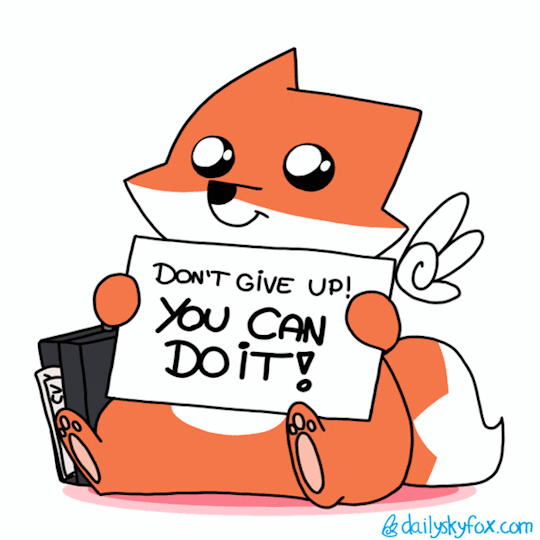
Interview Homework
Like a quote on Pinterest once said, “Proper preparation prevents poor performance”. Abraham Lincoln may not have said it, but if he had a fondness for alliteration, he probably would have. After all, he is the figure that said, “Give me six hours to chop down a tree and I will spend the first four sharpening the axe”. Preparation is where you win the interview. The interview is where you show the interviewer you won.
Research the Company
The first line of defense is a good offense, a well-known military strategy. The same goes with an interview. Researching the company is essential to create a positive impression. It shows you’ve prepared well, take the opportunity seriously, and may possess a few ideas on how to contribute. Not all research is created equal. It’s important to land on a few key areas. These areas will prepare you to freestyle if any unexpected questions arise; they also showcase how thoughtfully you’ve considered the company, its industry, and its potential roadmap.
When researching, find the answer to these questions:
How do they view themselves?
What sets them apart in their particular niche or field?
What are keywords that showcase their uniqueness?
What are some ways that their intention may fall short of the reality?
If possible, learn about these areas:
Recent news and/or highlights.
You can find this out in the PR/News section of their website—companies love to brag about themselves understandably. Check out their social media channels, including their Twitter, LinkedIn, and Facebook for news. For negative things (or less-glamorous news), ask ye olde search engine, Google. Type in the company’s name and hit “News” and a slew of information will be listed.
Most famous client and/or project.
Check out who their customers are and check out whether these organisations are small, mid-sized, or giant corporations. You’ll be able to get a grasp onto who their audience is, giving you information on what their potential business goals may be. Additionally, it sheds light on a specific company’s niche: they may be selling accounting software to airlines or FitBits to dog food companies. If they’ve historically been selling FitBits to dog food manufacturers but also landed a big project with an agricultural firm, this could give you ideas about you’re a great fit as they expand.
Know the Job Position
This may be the most “Dad-like” advice—ahem, obvious—but it’s an important point to thoroughly investigate. Look over the job description, and take some notes. A little exercise might be helpful:
Print out the job description
Pick a colored marker or pen and circle skills or areas you have direct experience in, that was your main “job”.
Pick another colored marker and circle skills or areas you do not have direct experience in, but have been related. ie. you ran a company’s social media, but learned to create infographics.
Write down how you’ve developed and/or learned these skills, like attending a webinar or an online course.
Your “direct skills” education
Your “related skills” education
Write down why this job position stood out to you personally—do you have a particular passion about the product, the industry, etc? Why are YOU drawn to it?
Know Why You’re a Fit
Use the earlier job description analysis to help you build a story in your mind about why you’re a fit. This is the time to reflect on possible questions or concerns the interviewer might have, “You worked as cosmetics store manager and now you want to work as a Data Scientist at our company?” Highlight how you taught yourself, took online courses, and always had interest in computers (your thesis was on how cybersecurity after multi-stakeholder organizations). Don’t be ashamed of your past; this is your story: own it and then construct the narrative.
Practice Talking About Yourself
Now that you know you’re a fit and you’re taking control of your narrative, it’s practice time. Another quote coming your way: “Practice makes perfect”. Interviews are often a nerve-racking affair. However practice is the proverbial shot of Vodka to interview anxiety. It makes things a bit better. You’ll know what to expect and how to answer. Use the list of common interview questions below to make flashcards or have a friend interview you. Research by Rice University and Michigan State University shows that "deliberate practice” or “engagement in structured activities created specifically to improve performance” as the biggest predictor for success and performance improvement.
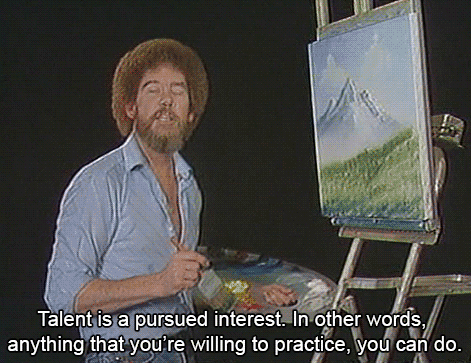
What is deliberate practice?
Deliberate practice is purposeful and systematic; it requires focused attention over a period of time. A famed golfer, Ben Hogan, broke down each section of the golf game and studied how to master each section.
Similarly, deliberately break down each step of the interview process:
the introduction/overview,
insight into skills and experiences
the “challenges” faced
odd-ball questions (questions about industry, position, random trivia)
availability
closing questions.
DURING THE INTERVIEW
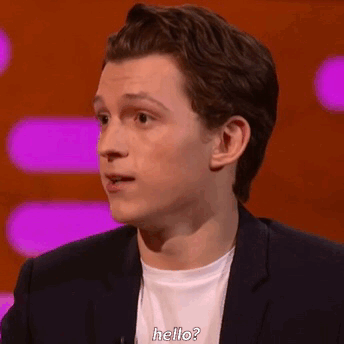
Show up on time.
If you’re a person that has a habit of arriving late. Make it your goal to get there 30 minutes beforehand. Being late to an interview puts you on the weaker foot; remember YOU’RE the prize—finding dedicated and skilled talent these days is getting tough. When you’re running behind schedule, you forfeit that hand. Now you just look like the genius who is a jerk. Avoid being late at all costs. If you're lucky enough to be having a video interview (video interviews means worrying less about road traffic), still make eye contact and be on time.
Always Call Casual Cannibals Into Pink Washpots
Don’t worry, you won’t have to call a cannibal anywhere—it’s a pneumonic device to help you remember 8 essential characteristics to exude in an interview: be authentic, concise, confident, interested, passionate, and warm. The (video) interview should be a pleasure to hold, both for you and your interviewer(s). These traits are guideposts in what important feelings to project, from the moment you shake their hand till you send a follow-up email. With a video job interview, you may want to emphasize body language, eye contact, or vocal pauses or a bit more. In video interviews, sometimes the camera may disengage, so be sure to make the potential employer can see you emotionally connect with questions.
Authentic
No need to be anyone else but you, boo. Really. You got this interview, so be the best version of yourself. The real “you” may be a person who prefers to observe and stay silent or be a slob at home. At an interview, you’re showcasing how you’ll be at the workplace, what kind of colleague you’ll be. Remember, job interviews are meant to assess fit between the organization and employee. This experience, an in-person interview or video, should be unique and mutually beneficial. Being authentic is one way to assure a match.
Concise
You’ve practiced your responses. Great. Be sure to keep responses under 90 seconds. That doesn’t necessarily mean taking the whole 90 seconds, but in general keep your answers to the point. Add emotion to them, if appropriate. In video interviews, be sure the camera is capturing your expressions.
Confidence
Keep things upbeat and positive. Remain confident in outlining how your skills align perfectly with the job requirements. Don’t feel ashamed or anxious about gaps in your resume; be confident in how you present them and how hard you worked to make up for any deficiencies. Employers want to see people who know their skillset is solid, but also confident to highlight their weak points and how they’re addressing them. In interview videos, be sure to come across sincere with marked pauses, emphatic head nods, and at least one ear-to-ear smile.
Passionate
Employers receive several applications for a position. If you’re interviewing for big corporations like Google, they receive thousands of applications. Share what excites you. Tell why this job aligns with your personal values and goals. Passion is one of those traits that’s difficult to hide or fake..
Warmth
Your hands may be a little clammy from nerves, but keep the conversation warm and easy-going. How to show warmth? When you’re doing prep work, jot down some potential warmth-inducing stories. Even if it's not in-person interview, a candidate story creates a special memory for the interviewer.
“Tell Me About Yourself”
This may be the most dreaded question in an interview. “Um…I studied Chemistry and like bread?” It’s a tough one as its encompassing and open-ended. This is simply an introductory question; as the interview progresses, they’ll be able to learn more about you from your later responses. To assist you in answering this, examine yourself:
What am I good at?
What do I enjoy?
What is the unique way I approach a problem?
Give an example of how that happened in the workplace

The Interviewer’s Secret 3 Questions
At the core, a potential employer has 3 essential questions. The questions that interviewers wish they could ask, but try to answer for themselves:
“What’s it like working with you?”
They’re trying to answer whether you’ll be a cool person to work with. Again they know they’ll be spending considerable time alongside you; they don’t want to hire a jerk or someone that doesn’t contribute to a team project. The more you share, the better picture they’ll gain about working with you.
“Are you a willing learner?”
Are you a person that is teachable? Do you have a good attitude about trying to learn new things? Or are you a person that doesn’t really value trying to learn new skills as needed? Most employers understand if you don’t have the tools necessary for the job; they’re looking for someone who is an eager student.
“Do you take the initiative?”
No one wants a team member that waits for instruction. Are you an individual that has taken on new challenges and projects because that’s what your past employer needed—even before the employer realized it? Highlight your initiate with an example or two. Show the interviewer you can “pull your weight”, while still always trying to contribute to the larger team’s success. Self-starters are a great addition to any team.
Any other special tips if it's a video interview?
Interviewing videos and in-person interviews differ by only one variable: creating the best setting for a video interview. Luckily that's one variable within your control. Video interviewing is very much a candidate-centric approach to interviews. It gives a candidate and those scheduling job interviews a range of conveniences. For a video interview, you may want to keep these key choices in mind:
Use a well-lit space
Interviewers want to see your face; video interviews with good lighting goes a long way. It’s a little odd when people’s faces are in the dark. That may be the primates in us speaking, but we don’t really tend to trust those in dark lighting. Find a room or corner that has natural light that hits your face. Be sure that the light is not behind you, otherwise your face will be in a shadow.
Eliminate a distracting background
A video interview may be an excuse to clean up your living space. Clear out any distracting pieces of artwork, clothes, or anything else that may make an interviewer go, “Wow, that’s a little messy” or “That’s a bit inappropriate”. If you have any questions, stray on the more conservative side. If your prize, mounted stuffed pig head seems a bit too much, just take down for the video interview.
Check your tools (camera, phone, connection, etc.)
Double check that your Internet connection is fast and reliable. You may want to check out Speedtest.net the day before an interview. As a broadband speed testing tool, it assists in measuring how quickly your connection is. If you do it the day before, chances that connection will crash minimizes. Be sure your camera is up and running. You may want to do a test call with a sibling or friend. If your video interview is on-the-go, make sure your phone is charged, or have a charging cord nearby.
Dress simply
In a video interview, an employer typically sees only above your shoulders via the camera. Which is great if you're just wearing pajama pants. Focus on wearing non-distracting clothing. Sometimes even the most fabulous outfits don't translate that well on video. Wear a simple blouse or collared shirt for video interviews that will allow them to concentrate on you.
Interviews, video or not, don’t have to be intimidating. It’s a conversation where you get to showcase your professional narrative and interject what makes you so special.
Retorio is a video-based behavioral assessment powered by AI. It uses facial expression, language, gesture, and voice to create a Big 5 Personality profile. Companies like BMW and Lufthansa, leverage Retorio's AI to support their own talent management teams.
LEARN WHAT MAKES ELON MUSK, ELON MUSK?

Popular Posts You May Like:
Which Psychological Defenses Do You Bring to Work?
Use These 5 Psychology Tricks for Your Next Video Interview
Taylor Swift Highlights a BAD (Blood) Candidate Experience
#psychology#interviewtips#interview#video interview#big5#ai hiring solutions#hiring agency#diversity hiring consultants#hiring#recruitment#recruiter#interviewhacks#hacker news#hackernoon
1 note
·
View note
Text
5 types of freshers and their favorites!
While quarantine has indeed changed a lot of things but one thing that remains a constant is exploring the new collection, fashion blogs by HYPE. And shopping online from HYPE. Store.Discover the ultimate HYPE. collections and amazing write-ups found at HYPE. blogs and the favorites contain one of the interesting things.
THE MUMMAS KID
Never left mum’s side, therefore never washed clothes, never washed dishes and never made a bed. (Wears sensible shoes)
THE POSH ONES
The ones who don’t understand the £1.50 jager bombs and the kebabs after a night out. The Ex-private school member who casually drops into conversation that their parents have a holiday home in the South of France.
THE UNPREPARED ONES
Confused about everything, especially when it comes to signing up for uni activities.
THE HERMIT ROOMMATE
You know they’re there, but they’re not. Only venture out to go to uni, the library or Tesco Express. A modern day Cinderella.
THE KEENO’S
You mentioned your name 3 minutes ago, and they’ve already given you a nickname. The ones who will do random acts so they can tell their friends back home the stories; wearing traffic cones as hats and luring neighbours cats in for a cuddle on the way back from a night out.
SOME OTHER STUFF
When it comes to backpacks, the very first thing that comes on mind is the classic style of the HYPE that offers iconic colors, prints and styles.
The ‘Buzz Backpack’ – created in a collaboration with Disney’s TOY STORY. We recreated Buzz Lightyears starship. The backpack itself features a transparent window which looks inside the bag, replicating windows. Showing off the insulated metallic lining, with printed Jet Boosters, and Starship Armour.
Thinking about little ones’ fashion?
Go for Disney backpacks
HYPE DISNEY MARIE FUR BACKPACK

There is a plethora of reasons to choose HYPE. disney backpacks from! Whether it’s about best pencil case or clothing, HYPE. offers ultimate kids jackets, sliders, face masks etc.
WHITE FUR BACKPACK SHAPE, 7CM MARIE BADGE ON FRONT POCKET, PINK BOW ON TOP OF BACKPACK, PINK WEBBING
85% Polyester 10% Acrylic 5% Cotton
External front zip pocket, adjustable padded straps and back for comfort, grab handle, embroidered crest, hypexdisney sew in label
With each style resembling Disney and Pixar movie characters’ instantly-recognisable features and personality, don’t be surprised if you’re adding them all to your basket.
Stumble on our exciting new collection of Disney clothing inspired by Mickey, Minnie & the gang in the 90’s.Explore our character covered collection of Sweats, T-shirts, Tape Sets and Accessories at official Hype store. Try Now Buy Later with Klarna. Hassle-free Returns. 15% Student Discount with UniDays
If you are checking bags, don’t forget to check best pencil case:
HYPE DISNEY NEMO PENCIL CASE

An evolution of pencil cases, in holographic, denim, sequins and PVC. Each Disney and Pixar character personality is matched perfectly with the fabrics. A magical home for your pens (and small snacks).
Who says bags, backpacks, pencil cases and accessories? Also discover HYPE. treats that will cater to your sweet tooth needs with HYPE. treats. Take a scroll down our virtual sweetshop and treat yourself to chocolatey goodness with Reese’s Peanut Butter Cups, or if you’re tickling for something less salty and more sweet, the Wonka Nerds are your go-to. Grab some mega marshmallows for your Saturday afternoon bbq, or start your day the right way with the General Mills Reese’s Puffs Cereal. Whatever you’re fancying, we’ve got the treats especially for you!
EXPLORE THESE:
Jolly Rancher:

Jolly Rancher is the candy you suck for long-lasting, bold fruit flavor! Whatever life throws at you, #KeepOnSucking!
Returns
Just Hype is happy to accept and refund unopened, undamaged treats and within the sell-by date so long as they are returned to us within 7 day of delivery. Returns must be sent via tracked & signed delivery, you must provide us with the tracking number.
Allergies
We cannot guarantee that Hype Treats do not contain traces of nuts as we purchase from a variety of manufacturers.
All items clearly state ingredients and, have a clear description of any allergens found in the products along with any colours or sweeteners. Please ensure that you have read the allergens information as this can vary from product to product as Hype Treats shall not accept any responsibility for this..
Just Hype shall be entitled to alter, change, modify & add to these Terms and Conditions at any time, you should check these shop terms periodically for changes. By placing an order through Just Hype after we post any changes to the shop terms, you agree to accept those changes, whether or not you have reviewed them.
*Unless expressly indicated in the product description, Hype treats are not the manufacturer of the treats. While we work to ensure that product information on our website is correct, manufacturers may alter their product information. Actual product packaging and materials may contain more and/or different information than shown on our website. If you have any specific product queries, please contact the manufacturer.
HERSHEY’S TWIZZLERS STRAWBERRY TWISTS BAGS 198G

he classic bright red liquorice twists from Hershey’s. These Strawberry flavoured Twizzlers are a classic choice that pairs well with movies, road trips and everything else you pair things with.
Returns
Just Hype is happy to accept and refund unopened, undamaged treats and within the sell-by date so long as they are returned to us within 7 day of delivery. Returns must be sent via tracked & signed delivery, you must provide us with the tracking number.
Allergies
We cannot guarantee that Hype Treats do not contain traces of nuts as we purchase from a variety of manufacturers.
All items clearly state ingredients and, have a clear description of any allergens found in the products along with any colours or sweeteners. Please ensure that you have read the allergens information as this can vary from product to product as Hype Treats shall not accept any responsibility for this..
Just Hype shall be entitled to alter, change, modify & add to these Terms and Conditions at any time, you should check these shop terms periodically for changes. By placing an order through Just Hype after we post any changes to the shop terms, you agree to accept those changes, whether or not you have reviewed them.
*Unless expressly indicated in the product description, Hype treats are not the manufacturer of the treats. While we work to ensure that product information on our website is correct, manufacturers may alter their product information. Actual product packaging and materials may contain more and/or different information than shown on our website. If you have any specific product queries, please contact the manufacturer.
For real time shopping experience, you must shop online form the official online HYPE. Store and cherish the savings!
0 notes
Text
LAW # 30 : MAKE YOUR ACCOMPLISHMENTS SEEM EFFORTLESS
JUDGEMENT
Your actions must seem natural and executed with ease. All the toil and practice that go into them, and also all the clever tricks, must be concealed. When you act, act effortlessly, as if you could do much more. Avoid the temptation of revealing how hard you work—it only raises questions. Teach no one your tricks or they will be used against you.
KANO TANNYU. MASTER ARTIST
Date Masamune once sent for Tannyu to decorate a pair of gold screens seven feet high. The artist said he thought black-and-white sketches would suit them, and went home again after considering them carefully. The next morning he came early and made a large quantity of ink into which he dipped a horseshoe he had brought with him, and then proceeded to make impressions of this all over one of the screens. Then, with a large brush, he drew a number of lines across them. Meanwhile Masamune had come in to watch his work, and at this he could contain his irritation no longer, and muttering, “What a beastly mess!” he strode away to his own apartments. The retainers told Tannyu he was in a very bad temper indeed. “He shouldn’t look on while I am at work, then,” replied the painter, “he should wait till it is finished.” Then he took up a smaller brush and dashed in touches here and there, and as he did so the prints of the horse-shoe turned into crabs, while the big broad strokes became rushes. He then turned to the other screen and splashed drops of ink all over it, and when he had added a few brush-strokes here and there they became a flight of swallows over willow trees. When Masamune saw the finished work he was as overjoyed at the artist’s skill as he had previously been annoyed at the apparent mess he was making of the screens.
CHA-NO-YU: THE JAPANESE TEA CEREMONY A. L. SADLER, 1962
OBSERVANCE OF THE LAW I
The Japanese tea ceremony called Cha-no-yu (“Hot Water for Tea”) has origins in ancient times, but it reached its peak of refinement in the sixteenth century under its most renowned practitioner, Sen no Rikyu. Although not from a noble family, Rikyu rose to great power, becoming the preferred tea master of the Emperor Hideyoshi, and an important adviser on aesthetic and even political matters. For Rikyu, the secret of success consisted in appearing natural, concealing the effort behind one’s work.
One day Rikyu and his son went to an acquaintance’s house for a tea ceremony. On the way in, the son remarked that the lovely antique-looking gate at their host’s house gave it an evocatively lonely appearance. “I don’t think so,” replied his father, “it looks as though it had been brought from some mountain temple a long way off, and as if the labor required to import it must have cost a lot of money.” If the owner of the house had put this much effort into one gate, it would show in his tea ceremony—and indeed Sen no Rikyu had to leave the ceremony early, unable to endure the affectation and effort it inadvertently revealed.
On another evening, while having tea at a friend’s house, Rikyu saw his host go outside, hold up a lantern in the darkness, cut a lemon off a tree, and bring it in. This charmed Rikyu—the host needed a relish for the dish he was serving, and had spontaneously gone outside to get one. But when the man offered the lemon with some Osaka rice cake, Rikyu realized that he had planned the cutting of the lemon all along, to go with this expensive delicacy. The gesture no longer seemed spontaneous—it was a way for the host to prove his cleverness. He had accidentally revealed how hard he was trying. Having seen enough, Rikyu politely declined the cake, excused himself, and left.
Emperor Hideyoshi once planned to visit Rikyu for a tea ceremony. On the night before he was to come, snow began to fall. Thinking quickly, Rikyu laid round cushions that fit exactly on each of the stepping-stones that led through the garden to his house. Just before dawn, he rose, saw that it had stopped snowing, and carefully removed the cushions. When Hideyoshi arrived, he marveled at the simple beauty of the sight—the perfectly round stepping stones, unencumbered by snow—and noticed how it called no attention to the manner in which Rikyu had accomplished it, but only to the polite gesture itself.
After Sen no Rikyu died, his ideas had a profound influence on the practice of the tea ceremony. The Tokugawa shogun Yorinobu, son of the great Emperor Ieyasu, was a student of Rikyu’s teachings. In his garden he had a stone lantern made by a famous master, and Lord Sakai Tadakatsu asked if he could come by one day to see it. Yorinobu replied that he would be honored, and commanded his gardeners to put everything in order for the visit. These gardeners, unfamiliar with the precepts of Cha-no-yu, thought the stone lantern misshapen, its windows being too small for the present taste. They had a local workman enlarge the windows. A few days before Lord Sakai’s visit, Yorinobu toured the garden. When he saw the altered windows he exploded with rage, ready to impale on his sword the fool who had ruined the lantern, upsetting its natural grace and destroying the whole purpose of Lord Sakai’s visit.
When Yorinobu calmed down, however, he remembered that he had originally bought two of the lanterns, and that the second was in his garden on the island of Kishu. At great expense, he hired a whale boat and the finest rowers he could find, ordering them to bring the lantern to him within two days—a difficult feat at best. But the sailors rowed day and night, and with the luck of a good wind they arrived just in time. To Yorinobu’s delight, this stone lantern was more magnificent than the first, for it had stood untouched for twenty years in a bamboo thicket, acquiring a brilliant antique appearance and a delicate covering of moss. When Lord Sakai arrived, later that same day, he was awed by the lantern, which was more magnificent than he had imagined—so graceful and at one with the elements. Fortunately he had no idea what time and effort it had cost Yorinobu to create this sublime effect.
THE RESILING MASTER
There was once a wrestling master who was versed in 360 feints and holds. He took a special liking to one of his pupils, to whom he taught 359 of them over a period of time. Somehow he never got around to the last trick. As months went by the young man became so proficient in the art that he bested everyone who dared to face him in the ring. He was so proud of his prowess that one day he boasted before the sultan that he could readily whip his master, were it not out of respect for his age and gratitude for his tutelage.
The sultan became incensed at this irreverence and ordered an immediate match with the royal court in attendance.
At the gong the youth barged forward with a lusty yell, only to be confronted with the unfamiliar 360th feint. The master seized his former pupil, lifted him high above his head, and flung him crashing to the ground. The sultan and the assembly let out a loud cheer. When the sultan asked the master how he was able to overcome such a strong opponent, the master confessed that he had reserved a secret technique for himself for just such a contingency. Then he related the lamentation of a master of archery, who taught everything he knew. “No one has learned archery from me,” the poor fellow complained, “who has not tried to use me as a butt in the end.”
A STORY OF SAADI, AS TOLD IN THE CRAFT OF POWER, R.G. H. SIU, 1979
Interpretation
To Sen no Rikyu, the sudden appearance of something naturally, almost accidentally graceful was the height of beauty. This beauty came without warning and seemed effortless. Nature created such things by its own laws and processes, but men had to create their effects through labor and contrivance. And when they showed the effort of producing the effect, the effect was spoiled. The gate came from too far away, the cutting of the lemon looked contrived.
You will often have to use tricks and ingenuity to create your effects—the cushions in the snow, the men rowing all night—but your audience must never suspect the work or the thinking that has gone into them. Nature does not reveal its tricks, and what imitates nature by appearing effortless approximates nature’s power.
OBSERVANCE OF THE LAW II
The great escape artist Harry Houdini once advertised his act as “The Impossible Possible.” And indeed those who witnessed his dramatic escapes felt that what he did onstage contradicted commonsense ideas of human capacity.
One evening in 1904, an audience of 4,000 Londoners filled a theater to watch Houdini accept a challenge: to escape from a pair of manacles billed as the strongest ever invented. They contained six sets of locks and nine tumblers in each cuff; a Birmingham maker had spent five years constructing them. Experts who examined them said they had never seen anything so intricate, and this intricacy was thought to make them impossible to escape.
The crowd watched the experts secure the manacles on Houdini’s wrists. Then the escape artist entered a black cabinet on stage. The minutes went by; the more time passed, the more certain it seemed that these manacles would be the first to defeat him. At one point he emerged from the cabinet, and asked that the cuffs be temporarily removed so that he could take off his coat—it was hot inside. The challengers refused, suspecting his request was a trick to find out how the locks worked. Undeterred, and without using his hands, Houdini managed to lift the coat over his shoulders, turn it inside out, remove a penknife from his vest pocket with his teeth, and, by moving his head, cut the coat off his arms. Freed from the coat, he stepped back into the cabinet, the audience roaring with approval at his grace and dexterity.
Finally, having kept the audience waiting long enough, Houdini emerged from the cabinet a second time, now with his hands free, the manacles raised high in triumph. To this day no one knows how he managed the escape. Although he had taken close to an hour to free himself, he had never looked concerned, had shown no sign of doubt. Indeed it seemed by the end that he had drawn out the escape as a way to heighten the drama, to make the audience worry—for there was no other sign that the performance had been anything but easy. The complaint about the heat was equally part of the act. The spectators of this and other Houdini performances must have felt he was toying with them: These manacles are nothing, he seemed to say, I could have freed myself a lot sooner, and from a lot worse.
Over the years, Houdini escaped from the chained carcass of an embalmed “sea monster” (a half octopus, half whalelike beast that had beached near Boston); he had himself sealed inside an enormous envelope from which he emerged without breaking the paper; he passed through brick walls; he wriggled free from straitjackets while dangling high in the air; he leaped from bridges into icy waters, his hands manacled and his legs in chains; he had himself submerged in glass cases full of water, hands pad-locked, while the audience watched in amazement as he worked himself free, struggling for close to an hour apparently without breathing. Each time he seemed to court certain death yet survived with superhuman aplomb. Meanwhile, he said nothing about his methods, gave no clues as to how he accomplished any of his tricks—he left his audiences and critics speculating, his power and reputation enhanced by their struggles with the inexplicable. Perhaps the most baffling trick of all was making a ten-thousand-pound elephant disappear before an audience’s eyes, a feat he repeated on stage for over nineteen weeks. No one has ever really explained how he did this, for in the auditorium where he performed the trick, there was simply nowhere for an elephant to hide.
The effortlessness of Houdini’s escapes led some to think he used occult forces, his superior psychic abilities giving him special control over his body. But a German escape artist named Kleppini claimed to know Houdini’s secret: He simply used elaborate gadgets. Kleppini also claimed to have defeated Houdini in a handcuff challenge in Holland.
Houdini did not mind all kinds of speculation floating around about his methods, but he would not tolerate an outright lie, and in 1902 he challenged Kleppini to a handcuff duel. Kleppini accepted. Through a spy, he found out the secret word to unlock a pair of French combination-lock cuffs that Houdini liked to use. His plan was to choose these cuffs to escape from onstage. This would definitively debunk Houdini—his “genius” simply lay in his use of mechanical gadgets.
On the night of the challenge, just as Kleppini had planned, Houdini offered him a choice of cuffs and he selected the ones with the combination lock. He was even able to disappear with them behind a screen to make a quick test, and reemerged seconds later, confident of victory.
Acting as if he sensed fraud, Houdini refused to lock Kleppini in the cuffs. The two men argued and began to fight, even wrestling with each other onstage. After a few minutes of this, an apparently angry, frustrated Houdini gave up and locked Kleppini in the cuffs. For the next few minutes Kleppini strained to get free. Something was wrong—minutes earlier he had opened the cuffs behind the screen; now the same code no longer worked. He sweated, racking his brains. Hours went by, the audience left, and finally an exhausted and humiliated Kleppini gave up and asked to be released.
The cuffs that Kleppini himself had opened behind the screen with the word “C-L-E-F-S” (French for “keys”) now clicked open only with the word “F-R-A-U-D.” Kleppini never figured out how Houdini had accomplished this uncanny feat.
Keep the extent of your abilities unknown. The wise man does not allow his knowledge and abilities to be sounded to the bottom, if he desires to be honored by all. He allows you to know them but not to comprehend them. No one must know the extent of his abilities, lest he be disappointed. No one ever has an opportunity of fathoming him entirely. For guesses and doubts about the extent of his talents arouse more veneration than accurate knowledge of them, be they ever so great.
BALTASAR GRACIÁN. 1601-1658
Interpretation
Although we do not know for certain how Houdini accomplished many of his most ingenious escapes, one thing is clear: It was not the occult, or any kind of magic, that gave him his powers, but hard work and endless practice, all of which he carefully concealed from the world. Houdini never left anything to chance—day and night he studied the workings of locks, researched centuries-old sleight-of-hand tricks, pored over books on mechanics, whatever he could use. Every moment not spent researching he spent working his body, keeping himself exceptionally limber, and learning how to control his muscles and his breathing.
Early on in Houdini’s career, an old Japanese performer whom he toured with taught him an ancient trick: how to swallow an ivory ball, then bring it back up. He practiced this endlessly with a small peeled potato tied to a string—up and down he would manipulate the potato with his throat muscles, until they were strong enough to move it without the string. The organizers of the London handcuff challenge had searched Houdini’s body thoroughly beforehand, but no one could check the inside of his throat, where he could have concealed small tools to help him escape. Even so, Kleppini was fundamentally wrong: It was not Houdini’s tools but his practice, work, and research that made his escapes possible.
Kleppini, in fact, was completely outwitted by Houdini, who set the whole thing up. He let his opponent learn the code to the French cuffs, then baited him into choosing those cuffs onstage. Then, during the two men’s tussle, the dexterous Houdini was able to change the code to “F-R-A-U-D.” He had spent weeks practicing this trick, but the audience saw none of the sweat and toil behind the scenes. Nor was Houdini ever nervous; he induced nervousness in others. (He deliberately dragged out the time it would take to escape, as a way of heightening the drama, and making the audience squirm.) His escapes from death, always graceful and easy, made him look like a superman.
As a person of power, you must research and practice endlessly before appearing in public, onstage or anywhere else. Never expose the sweat and labor behind your poise. Some think such exposure will demonstrate their diligence and honesty, but it actually just makes them look weaker—as if anyone who practiced and worked at it could do what they had done, or as if they weren’t really up to the job. Keep your effort and your tricks to yourself and you seem to have the grace and ease of a god. One never sees the source of a god’s power revealed; one only sees its effects.
A line [of poetry] will take us hours maybe;
Yet if it does not seem a moment’s thought,
Our stitching and unstitching has been naught.
Adam’s Curse, William Buller Yeats, 1865-1939
KEYS TO POWER
Humanity’s first notions of power came from primitive encounters with nature—the flash of lightning in the sky, a sudden flood, the speed and ferocity of a wild animal. These forces required no thinking, no planning—they awed us by their sudden appearance, their gracefulness, and their power over life and death. And this remains the kind of power we have always wanted to imitate. Through science and technology we have re-created the speed and sublime power of nature, but something is missing: Our machines are noisy and jerky, they reveal their effort. Even the very best creations of technology cannot root out our admiration for things that move easily and effortlessly. The power of children to bend us to their will comes from a kind of seductive charm that we feel in the presence of a creature less reflective and more graceful than we are. We cannot return to such a state, but if we can create the appearance of this kind of ease, we elicit in others the kind of primitive awe that nature has always evoked in hu mankind.
One of the first European writers to expound on this principle came from that most unnatural of environments, the Renaissance court. In The Book of the Courtier, published in 1528, Baldassare Castiglione describes the highly elaborate and codified manners of the perfect court citizen. And yet, Castiglione explains, the courtier must execute these gestures with what he calls sprezzatura, the capacity to make the difficult seem easy. He urges the courtier to “practice in all things a certain nonchalance which conceals all artistry and makes whatever one says or does seem uncontrived and effortless.” We all admire the achievement of some unusual feat, but if it is accomplished naturally and gracefully, our admiration increases tenfold—“whereas ... to labor at what one is doing and ... to make bones over it, shows an extreme lack of grace and causes everything, whatever its worth, to be discounted.”
Much of the idea of sprezzatura came from the world of art. All the great Renaissance artists carefully kept their works under wraps. Only the finished masterpiece could be shown to the public. Michelangelo forbade even popes to view his work in process. A Renaissance artist was always careful to keep his studios shut to patrons and public alike, not out of fear of imitation, but because to see the making of the works would mar the magic of their effect, and their studied atmosphere of ease and natural beauty.
The Renaissance painter Vasari, also the first great art critic, ridiculed the work of Paolo Uccello, who was obsessed with the laws of perspective. The effort Uccello spent on improving the appearance of perspective was too obvious in his work—it made his paintings ugly and labored, overwhelmed by the effort of their effects. We have the same response when we watch performers who put too much effort into their act: Seeing them trying so hard breaks the illusion. It also makes us uncomfortable. Calm, graceful performers, on the other hand, set us at ease, creating the illusion that they are not acting but being natural and themselves, even when everything they are doing involves labor and practice.
The idea of sprezzatura is relevant to all forms of power, for power depends vitally on appearances and the illusions you create. Your public actions are like artworks: They must have visual appeal, must create anticipation, even entertain. When you reveal the inner workings of your creation, you become just one more mortal among others. What is understandable is not awe-inspiring—we tell ourselves we could do as well if we had the money and time. Avoid the temptation of showing how clever you are—it is far more clever to conceal the mechanisms of your cleverness.
Talleyrand’s application of this concept to his daily life greatly enhanced the aura of power that surrounded him. He never liked to work too hard, so he made others do the work for him—the spying, the research, the detailed analyses. With all this labor at his disposal, he himself never seemed to strain. When his spies revealed that a certain event was about to take place, he would talk in social conversation as if he sensed its imminence. The result was that people thought he was clairvoyant. His short pithy statements and witticisms always seemed to summarize a situation perfectly, but they were based on much research and thought. To those in government, including Napoleon himself, Talleyrand gave the impression of immense power—an effect entirely dependent on the apparent ease with which he accomplished his feats.
There is another reason for concealing your shortcuts and tricks: When you let this information out, you give people ideas they can use against you. You lose the advantages of keeping silent. We tend to want the world to know what we have done—we want our vanity gratified by having our hard work and cleverness applauded, and we may even want sympathy for the hours it has taken to reach our point of artistry. Learn to control this propensity to blab, for its effect is often the opposite of what you expected. Remember: The more mystery surrounds your actions, the more awesome your power seems. You appear to be the only one who can do what you do—and the appearance of having an exclusive gift is immensely powerful. Finally, because you achieve your accomplishments with grace and ease, people believe that you could always do more if you tried harder. This elicits not only admiration but a touch of fear. Your powers are untapped—no one can fathom their limits.
Image: The Racehorse. From up close we would see the strain, the effort to control the horse, the labored, painful breathing. But from the distance where we sit and watch, it is all gracefulness, flying through the air. Keep others at a distance and they will only see the ease with which you move.
Authority: For whatever action [nonchalance] accompanies, no matter how trivial it is, it not only reveals the skill of the person doing it but also very often causes it to be considered far greater than it really is. This is because it makes the onlookers believe that a man who performs well with so much facility must possess even greater skill than he does. (Baldassare Castiglione, 1478-1529)
REVERSAL
The secrecy with which you surround your actions must seem lighthearted in spirit. A zeal to conceal your work creates an unpleasant, almost paranoiac impression: you are taking the game too seriously. Houdini was careful to make the concealment of his tricks seem a game, all part of the show. Never show your work until it is finished, but if you put too much effort into keeping it under wraps you will be like the painter Pontormo, who spent the last years of his life hiding his frescoes from the public eye and only succeeded in driving himself mad. Always keep your sense of humor about yourself.
There are also times when revealing the inner workings of your projects can prove worthwhile. It all depends on your audience’s taste, and on the times in which you operate. P. T. Barnum recognized that his public wanted to feel involved in his shows, and that understanding his tricks delighted them, partly, perhaps, because implicitly debunking people who kept their sources of power hidden from the masses appealed to America’s democratic spirit. The public also appreciated the showman’s humor and honesty. Barnum took this to the extreme of publicizing his own humbuggery in his popular autobiography, written when his career was at its height.
As long as the partial disclosure of tricks and techniques is carefully planned, rather than the result of an uncontrollable need to blab, it is the ultimate in cleverness. It gives the audience the illusion of being superior and involved, even while much of what you do remains concealed from them.
12 notes
·
View notes
Text
The Complete Set (V x MC)
This is something like a continuation of another piece I did here. You don’t really need it for context, but I recommend it.
I honestly meant to contribute loads more to this event omg but the past few days have left me so deflated. Be damned if I’m going to miss V day, though.
The card was beautiful, with red ribbons and pressed flowers decorating the front. It sat on her doorstep as she left for work in an ivory box with a matching red ribbon, and the only clue that it belonged to her at all was the typewritten label bearing nothing but her name.
She had been on her way to work and did not have the time to go back, so as it was she put the box in her bag and gave it a second, third and fourth glance as she took the subway.
As she greeted her work colleagues, she was curious. By the time she got to her cubicle she could hardly wait. She did not even bother to turn on her computer and instead untied the red ribbon on the box, heart racing at the card within.
A message was printed on the inside in similarly intricate typeface:
Roses are red
Violets are blue
Somebody loves you
I wonder who?
She knew who she wanted it to be. In truth, her heart sank at the memory of being so publicly rejected. Even so, she was curious of the instructions underneath the poem. They referenced going to the goldfish bread stand outside of her work building at ten o'clock that morning, when the next stage of the Valentine would become clear.
It was probably a prank. She laughed about it even as she began her work for that morning. Someone was bound to be there with a camera, ready to point and laugh and stare as she collapsed into tears, just as she had before.
By 9, however, she had placed the card beside her computer monitor and by 9:45, she found herself eyeing the clock. If she never went, she reasoned, then she would never have answers.
And so she arrived at the goldfish bread stand at 9:58, with the card in her hands, unsure exactly what to say.
“I, uh,” she said as reached the front of the line, “I got this card, and-”
One look at the card and the vendor looked immediately enlightened.
“You!” He exclaimed. “I've been waiting for you!”
“You have?”
She was sure she had never met the man before, yet he seemed to have been expecting her. All of a sudden, she wondered if he was the one who sent the card.
“This was left for you,” he said, leaning under the counter for something. “He said I should give it to you if you came by.”
“He?”
It was a box. Exactly identical to the one from that morning.
“Thank you,” she said, ignoring the disappointed expression of the vendor as she rushed back to her cubicle. Presumably he had been curious of its contents or at least thought that she might buy something.
Inside of the second box was a card with a blue ribbon, equally as pretty as the first. She did not bother to be discreet this time around, staying on her feet as she cast aside the box.
As before, there was a poem inside of the card.
Roses are red
Violets are blue
Sugar is sweet
So is this clue
The “clue” was a business card from an ice cream parlor two blocks over. When she turned the card over, she realised that the sender had written down a time. She could barely decipher the handwriting, but she was scheduled to be on lunch at that time anyway.
She had actually never been to that particular ice cream place before, though she had heard Yoosung talk about it before on the messenger. They had a generous student discount and big portions and for a brief moment she wondered if maybe he was the one that had sent her the Valentine.
The moment she stepped through the door to the ice cream place with the card in her hand, the serving staff all gave one another the same expression as the vendor at the food cart. They, too, had been expecting her and she was more than a little bit apprehensive as she approached the cash registers.
They did not give her a box, however, but an overly large bowl of ice cream.
“I,” she said, glancing from the ice cream to the serving staff, all of whom seemed as perplexed by the situation as she was. “Thank you.”
As she took her seat, she glanced around the place for cameras, suddenly suspicious again that the entire thing was a prank. Why come to such a sudden stop just as the game had started going?
She prodded at the ice cream, wondering what she was missing and coming to the steady conclusion that perhaps that was the story of her love life; she had spent weeks wondering the same thing after V’s dismissal. If she was honest, she had hoped he was the sender.
She sat there for so long that the ice cream melted into a soupy mess at the bottom of the bowl and she stirred it halfheartedly, with the intention of leaving shortly afterwards. As she shifted it, however, she noticed that there were words printed on the bottom of her bowl. An address that she realised she recognized only too well.
She had been acting so strangely that morning that it did not take much to convince her colleagues that she needed the afternoon off. She knew that she was going to need the time.
Rika’s apartment still lay unoccupied. There was no longer a bomb, but in the months following that first RFA party, no one had returned. For a moment, she wondered if the password would even be the same and then wondered if to grateful when it was.
Despite everything, the apartment’s interior was exactly the same as when she had stayed there that previous year and she dropped her purse on the couch by force of habit, turning on her heel to try and find the next clue.
The next box had a purple ribbon and someone had positioned it on Rika’s desk. She was more hesitant about this one, pulling the ribbon cautiously and only considering at that point the possibility that it could be a trap.
Inside of the box was a third card with a matching purple ribbon.
Roses are red
Violets are blue
I'll tell you my story
If you figure this clue
Attached to the note was a key. Too small for a doorway, but small enough for any of the cabinets in Rika’s desk.
She knew that they had been cleared of confidential information for quite some time and yet still she hesitated before leaning down to try and match the key to any of the locks. When she realised it fit the biggest of the drawers, she took a deep breath and turned the key in the lock with such a loud creak that she was sure the universe knew she was up to no good.
Inside of the drawer was a package wrapped in ivory paper and tied with a purple ribbon. She closed the drawer, suddenly nervous, but curiosity got the better of her and she snatched it back out.
It was a photo album; leather backed and gilded lettering on the spine.
She sank down onto Rika’s couch before opening the front cover, smiling softly at the early photographs of the RFA. Photographs from Rika’s parties, pictures of her friends in a way she had never known them and never would, pictures of Rika and V laughing together with seemingly endless bottles of wine.
Everyone seemed so happy in those pictures and she wondered why the sender had wanted her to see them. Rika and V matched one another so perfectly, like the sunlight’s reflection across a clear ocean. She suddenly wished she had never seen it.
She skimmed forward a few pages, to the later parties, to the shadowy period when Rika finally disappeared and V fell into shadow on the occasions he was in the pictures at all. The photographs where nobody smiled and most of the photographs were a formality.
And then there was her photograph, at her first RFA party. Only in that moment did she realise how out of place her smile actually was. She had not believed them when they said she changed everything, but now she could see the way the dark cloud of Rika’s absence all but evaporated with her. After her first party, everyone smiled again. V smiled again. It was weak, but it was there.
She had never noticed the way he looked at her before. The small glances caught on camera as she made jokes. The way he gently linked his arm around her in her first official RFA group shot-
No
She had noticed before. She had taken soup to his apartment for fear he was not eating properly. She'd knitted him a scarf for the(rigged) RFA secret Santa. He was the one to insist she had it all wrong and she had respected it, even if it left her deeply miserable.
At the back of the album was one last envelope, adorned with a white ribbon and she opened it slowly, wondering what on earth she might find.
It was a single piece of paper, typewritten, dated three days after her confession. Her blood ran cold when she realised that it was a page of a journal.
“I told her I didn't care for her. I lied. I was a ghost when she met me. For a long time I lived and breathed but I was a dead man walking. I look at her, though, and I'm alive and looking forward to every day that I am able to spend with her.
And I cannot help but feel it is a luxury I don't deserve; as if I’ve stolen the North Star and am merely clinging onto it.”
On the back of the note were plans to meet at a coffee shop in the financial district at six that evening. He had not known that she would skip work, of course, but it was a cozy place and it gave her time to change out of her work clothes and into something less formal.
She did not know what she would say to him. She wondered what he meant to say to her. As it was, her mind was a scrambled mess right up until she saw him standing outside, a cardboard cup in his hand.
He had his back to her and her first instinct was to hide. Her second was to run to him and in the end she went with her third, which was to approach slowly and call him by his name.
“You followed the clues,” he said, “good. I-”
“Wait,” she said. “Wait, don't say a word.”
She wanted to ask him so many things, but in the end, settled on the simplest question.
“What you said…in your journal...was it true?”
“I meant it,” he said.
“I know that you wrote it a long time ago,” she said. “I don't know if you feel that way now...but I just want to say...you didn't steal anything.”
She sighed. Words were difficult.
“Any happiness you felt while you were with me, you found it on your own,” she said. “I was just there to guide you.”
She had told him not to speak but at that moment, she wished he would. He reached into the pocket of his coat and lifted out one final box, wrapped in a white ribbon.
“For you,” he said and passed it to her. She glanced from the box to him and slowly pulled back the ribbon.
Inside of the box was a pair of gloves, hand knitted and badly.
“I um...I watched a few tutorials on the internet,” said V, suddenly looking sheepish. “They match the scarf you made for me. In theory anyway.”
“You know,” she said, “if you wanted to learn, I could have taught you.”
“I like surprises.”
“So I’ve noticed.”
“We have a problem, though,” she said, slipping on the gloves and wiggling her fingers against the wool. “If only you have the scarf and only I the gloves, neither of us has the complete set.”
He laughed out loud at that and slipped a hand into hers.
“That is a predicament,” he said. “I suppose...we’ll have to be the complete set, won't we?”
She took in the sight of their joined hands, knowing it ought to have felt strange. She had thought about such a thing for almost as long as she had known V and had expected the sensation of his hand in hers to send her head spinning. It didn't, however. It felt normal; as if they were meant to hold one another’s hand at one point or another.
“I don't believe in soulmates,” she said, looking up into his eyes. “But I think we always were.”
99 notes
·
View notes
Text
The Mail Order American Dream Part II: The Hunt is On! An Extremely In-Depth Guide to Finding That House
Hello Friends! I’ve gotten a number of amazing emails about last week’s post on kit houses, and have decided (after many requests) to write a more in-depth guide to picking out mail order houses in the wild, using a few examples from my own hunt in Greensboro, North Carolina.
THIS IS A LONG ARTICLE. NOW IS THE TIME TO OPEN IN A NEW TAB OR OUTSIDE THE TUMBLR APP.
Preparing for Battle: Gathering Online and Print Resources
Like most obscure things in the world, there are several online communities for kit houses and their identification, and these communities have been very active in putting resources such as old catalogs online.
Here is a brief list of really helpful resources to get you started:
Online
1.) Comprehensive list of mail order home catalogs available online.
2.) Plans from AntiqueHomeStyle.com and AntiqueHome.org (these include some regional companies like Southern Pine Co. as well as materials on interiors and pattern book houses.
3.) The Daily Bungalow on Flickr - a valuable resource for supplemental material. Most (but not all) of the catalogs on this page are listed chronologically in Source 1.
4.) Complete Index of Aladdin Home Catalogs - every Aladdin catalog printed is available here. Totally worth a tab of its own.
5.) Sears’ Master List of Confirmed Sears Houses
Books
1.) Houses By Mail: A Guide to Houses from Sears, Roebuck & Co.
If your interest in mail order houses is more than a passing fancy, I recommend picking this book up, as it’s a handy and comprehensive guide organized by roof shape.
If you don’t feel like purchasing the book, Dale Hynes has put together Pinterest boards organizing the Sears houses in the same way as the book, and has an extra collection of houses not included in the guide.
2.) Houses from Books: Treatises, Pattern Books, and Catalogs in American Architecture, 1738-1950 by Daniel D. Reiff
If you’re serious about getting into the kit house game, this book is for you. It has great historical facts, and most importantly, examples of kit houses from the catalogs and how they’re built in real life. I recommend ordering this book directly from Penn State Press rather than Amazon, as it’ll save you $30 and the shipping is pretty rapid. My book came a mere two days after I ordered it.
Step 1: So You Think You’re Looking at a Kit House - Preliminary Signs
Location
If you remember from last week, kit homes are commonly found in 3 places:
1.) First Generation Suburbs (streetcar and railway)
For the purpose of this article, I’m going to use the neighborhood of College Hill, an early streetcar suburb of Greensboro. College Hill is outlined in red and is the bottom right with an arrow pointing at it saying ‘oldest suburbs’.

2.) Near industrial sites (as company housing)

3.) First Generation Auto Suburbs

BUT this is not always the case! Some kit houses were built as farmhouses on the outskirts of cities or in rural areas. It’s a case by case basis, which is why identifying kit houses is so fun!
Architectural Style
Last week, we went over styles that were common for kit houses, and if there are many houses of these styles grouped together, you might be looking at a kit house community!
You might also be looking at a pattern-book house community, which is more difficult to discern, because the execution of pattern book houses was left to the individual contractors and carpenters, and each local carpenter had their own style and flourishes.
Queen-Anne style houses, for example are more likely to be pattern book houses than kit houses because the height of their popularity was right before the beginning of mail order houses, though certain models ran as late as the 1930s, as we shall see.
Repetition
You might think you’re looking at a kit house neighborhood because you are looking at many houses that appear to be duplicates of each other. Houses that are identical or nearly identical to each other may be the most incriminating sign that you are looking at a kit house community, though pattern books may again be at fault.
Step 2: Pinpointing the House on a Map
1.) The Address
You cannot, I repeat, cannot identify whether or not a house was a kit house unless you have the address. If you are leaving the area where the house was found, write down the street name before you go, and fill out the details later via Google Maps.
For example, I’m going to use the example of 304 Tate Street, a house seen below.

2.) Getting photos at multiple angles
A good idea when looking to identify a house is to get multiple pictures: one from the front, and at least one from the side. This picture suffices because it is at an oblique angle, and details such as window layout can be seen clearly. The more complex a house is, the more angles you should try and capture.
(A good idea is to take screenshots in Google Street View.)
Step 3: Finding Your County’s Public Records
Unfortunately, most counties’ public records websites are difficult to locate, as they are usually pushed way down in search results by for-profit services. Here are some tricks for finding your county’s public records site without having to scour through several unhelpful and poorly-designed government websites.
1. Google the house’s address. If you see a result from Zillow or another real estate aggregator, click on it.
(I recommend Zillow because their layout is a little more detailed.)
Important: check Zillow to see if the house is currently a rental. This is important later on. In this case, it is a rental.

2. Scroll down until you see a little link saying “county website” or something similar. Click on this link.

3. A really ugly website will come up looking something like this. You will often see a row of links for different statistics. Click on one that says “Buildings”, “structures” or something similar.

4. Congrats! You’ve found a page just about your house! The best part is, you can find other records much more easily now. Somewhere at the top of your page, you will see something like “New Search.”

Open this link in a new tab, and keep it handy for quickly searching for different addresses. It should look something like this:

Bookmark this page for easy access if you’re searching for more than one kit house.
Step 4: Interpreting Your House’s Public Records
Go back to your house’s Building’s page.

We’re going to go over this page step by step in order to use this resource to the highest of its abilities.
A.) The Year Built
RULE NUMBER 1: HOUSES BUILT BEFORE 1908 ARE NOT MAIL-ORDER HOUSES. They are probably pattern book houses.
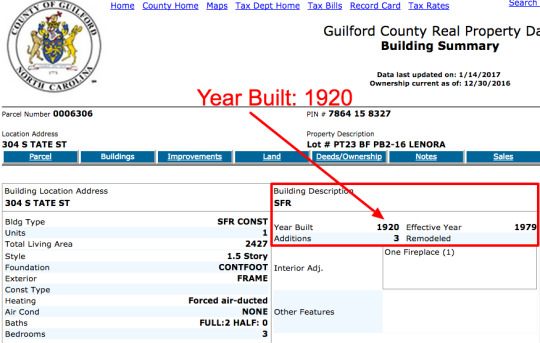
This is literally the most important piece of information in identifying kit houses. Without a date, it’s game over, as architectural styles last a lot longer than individual kit house models. You may be thinking you’re looking at your house, but if you don’t know the date, you could be 10 or 20 years off.
B.) Remodeling and Additions
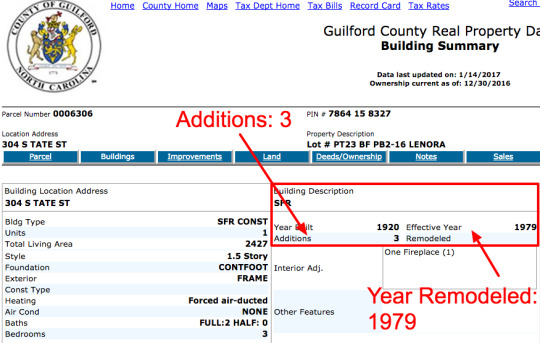
You know what this means: you’re looking at a house that’s not gonna look exactly like it does in the catalog. This is important. A lot of people get caught up in the idea that the kit house should match the catalog perfectly, when this is almost never the case. In this case, the house has 3 additions. Fortunately, additions are often in the back of the house, so the front facade should remain relatively unchanged.
We can reveal a lot from the fact that the renovations were done in 1979. This can mean a number of things:
Many of the renovations were probably upgrades such as central air and heating
Additions dating from an earlier time period (10-20 years after the house was built) are much more dangerous, because these were often aesthetic upgrades made so the house fit in more with the styles of the time. Additions from the 70s and after were most likely mechanical or safety improvements.
If the house is for rent, many of the adjustments may have been for the purpose of subdividing a house into apartments. In this case, the remodeling is interior. Common changes made by landlords when they turn a single family home into a multi-family dwelling include:
Removing fireplaces. In the screenshot, you’ll see a bit that says “Interior Adj.”: One Fireplace (1). This more often refers to removing or sealing off a fireplace than adding one, especially if the place is being rented out to college students.
Adding onto the back of the bottom story of a house. This is common because it’s the easiest way to create more space for less money.
Enclosing all or part of a front or rear porch. Again, this is an easy way to add livable/rentable square-footage.
C. Main and Addition Summary
Scroll down to the bottom of the page, and you should see a bit that looks like this. This is also a very helpful tidbit that will help in your identification:

This image lists the main structure along with all of the additions and their square footage, and their codes.
Here is how to read this image:
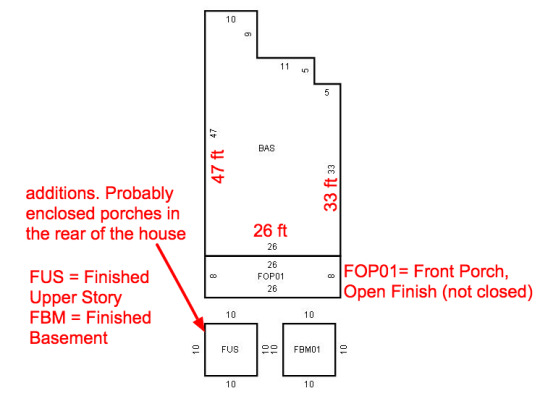
Basically, those little squares represent parcels of square-footage not found in the original blueprints, which helps a lot when looking at the plans in the house catalogs. The original dimensions of the house was 26 feet x 33 feet, as can be gleamed by the table and simple math.
D. Other Info (not as helpful)
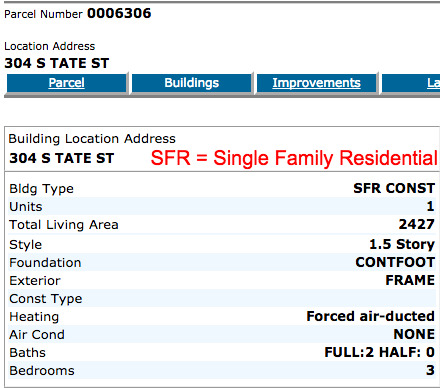
These represent the current stats of the house, and not necessarily the original house plans, so they’re not as useful as the other data available.
Step 5: Finding Your House - Catalog Time!
Okay, here’s the fun part, especially if you like millions of tabs. A good start is opening each of the online sources listed at the beginning of the article, in a new tab. Especially this one.
For SEARS HOUSES:
Have your copy of Houses By Mail or Dale’s Pinterest Page open to make quick work of the Sears catalog houses, which could otherwise take forever. These resources sort the houses by their shape, making comparison easy.
Each house has the catalog dates and model numbers, making elimination a breeze.
A.) For each non-Sears source, open the catalogs corresponding to the date your house was built in new tabs.
For example, my house was built in 1920. I would open each catalog from 1920 in a new tab. If you can’t find a specific catalog for your house year, (e.g. there’s no Montgomery Ward catalog for 1920), a good idea is to use the catalog from 1 or 2 years before the given date.
BUT KATE - Which companies should I include in my Search???? There are so Many! I would start with those whose business extended coast to coast. If you live on the West Coast, there are several resources for West Coast homes from AntiqueHomeStyle.com and AntiqueHome.org. For now, ignore pattern books.
Here are companies who should be included in your table:
Sears
Aladdin
Harris
Wardway (Montgomery Ward)
Lewis
Gordon Van Tine
Sterling
Bennett
Bolded ones are the most common.
B.) Make a Table for easy elimination
A good strategy for quick and easy elimination is to make a table with the following values as columns:
House Year
Address
Style (e.g. 1 story craftsman; foursquare)
(n number of columns for names of companies, so one column for Sears, one for Aladdin, one for Harris, etc.) Once a catalog is exhausted, if the plan was found, write the name in this columns; if not, x it out.
Notes
C.) If you have multiple models that look similar (we’ll get to this in a second.)
Either open similar images in new tabs and flip through them, or copy and paste the images (taking screenshots is your friends) into a document along with the pictures of the original house. For example:
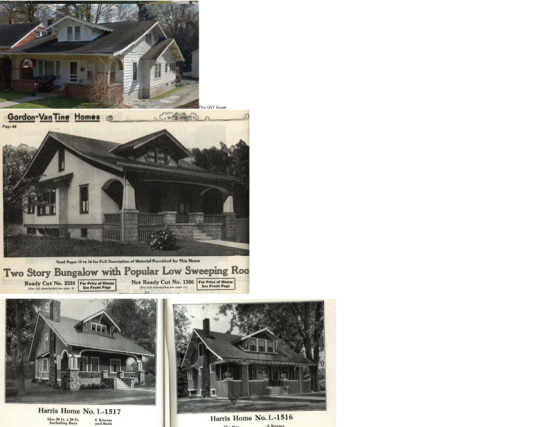
Step 6: Confirming Your Identification
Sometimes, it’s really easy to find the house you’re looking for. In the case of 304 Tate Street, a rather unusual house, I found it staring back at me from the pages of a Bennett Homes catalog, virtually untouched.


As we can see, there are some things that are slightly off, such as the windows on the side. The spacing between them is accurate once you take into account the different angles of the pictures. The dimensions match those from the chart earlier, ignoring the additions.
Things that are different: the house on Tate Street was built into a hill, which explains the different foundation. The columns are slightly different, but the placement is correct. The Tate Street house omitted the exposed rafters, a stylistic - not structural - decision.
A.) The Importance of Plans
Here’s an example that isn’t so easy but also isn’t impossible.


Spoilers, it’s this house:
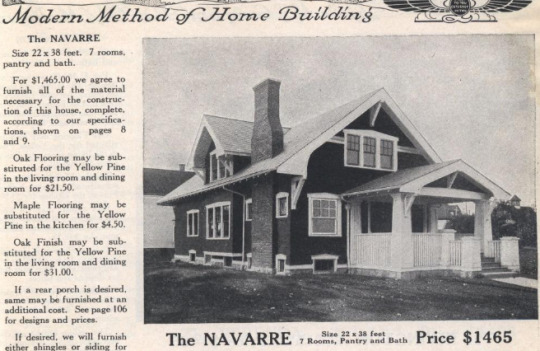
You’re probably saying, “no it’s not, idiot.” It’s true,
This is the difficulty of identifying a kit house that has been heavily modified from the original.
First of all, the plan is mirrored from the original, a common switch at the time of construction. Many catalogs provided mirrored versions of their plans. (Hence why the chimney is on the opposite side.)
The distinctiveness of elements such as the closed eaves and the overall layout of the house (with additions) compared to the plan, makes a confirmed spotting of this mail order house from Lewis Manufacturing, Co, built in 1920.


The entirety of the porch has been closed in and another room has been added to the front of the house.
During reroofing, the roofer chose not include the bit of roof that splits the first and second story of the cross-gable, leaving an indentation on both sides where that strip of roof used to be.
All of the windows have been replaced, leaving no originals. This happens frequently, as windows with the dimensions of the originals became rare, or too expensive to have custom built. The result is remodeling the house around more standard contemporary window shapes. This is how windows with three mullions get split into two, as can be seen on the side of the house.
B.) The Importance of Dates
Here’s another example. This one is recreated from page 276 of Daniel Reiff’s book Houses from Books. The heavily-modified house, a confirmed Sears Modern Home No. 170, built in 1915, is seen here with the original catalog drawing.

The point is, a remodeled kit house can look nothing like the original.
What makes it even more difficult is when the renovations do not change to the square footage or the mechanical systems of a home, leaving them unreported by public records. Often, small changes made to update the exterior of a home to a more popular style (often from newer house catalogs!) are difficult to trace.
Here are a list of things that are the most likely to be different from the catalog picture and the plans:
Building materials and colors.
Front porch layout (e.g. number of columns and their spacing/style)
Window size and style. Most kit house windows are almost never original.
Number of windows and window layout (such as omitting a middle window, or adding sidelights.)
Removal of small windows.
Enclosed porches
Removal of fireplaces (not necessarily chimney)
Chimney that is originally internal is moved to an exterior wall, which was less expensive to build back in the day.
Architectural details. Craftsman columns can now be Tuscan. Exposed rafters can be enclosed.
Plan is mirrored or partially mirrored.
Balconies removed/enclosed.
Carport or port cochere added
Here’s a list of things least likely to be different from the catalog picture and plans:
Removal of dormers
Removal of chimney
Total removal of porches
large changes in rooflines/roof structure
Chances are, if the side windows of the house look totally different from the original drawing, it’s more likely that you have the wrong identification. This is especially the case with Craftsman bungalows.
I leave you with one final example recreated from Reiff (p. 286). This house, built in 1909-10 was remodeled in 1929 to look like the Aladdin Standard.

This is why dates are SO IMPORTANT. House plans cannot travel back in time. If the plan dates after the house was built, the house is not built from that plan.
Well folks, there you have it.
I hope this has helped y’all with your kit house identification, as much as it has helped me streamline my own search.
Stay tuned for Thursday’s house roast FROM ALASKA. Yes, there are McMansions in Alaska. Next very special surprise McMansion Hell post that many of y’all have been asking for for months now.
If you like this post, and want to see more like it (plus get sweet access to behind the scenes stuff), consider supporting me on Patreon! Not into recurring donations? Check out the McMansion Hell Store - 30% goes to charity.
Copyright Disclaimer: unless otherwise, pictures are from the Public Domain.
#architecture#history#kit houses#sears houses#sears modern homes#wardway houses#gordon van tine#mail order houses#houses#1920s houses#victorian houses#house plans
465 notes
·
View notes